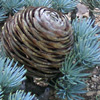Atlas cedar (Cedrus atlantica) is a tall conifer tree in the Pinaceae family. It forms a wide spreading canopy. Its needles are silvery-blue, stiff and bent up to 3 cm long. They are arranged in whorls at the tips of short spurs. Young trees have a more greenish color and a pyramid shaped canopy. The mature trees are bluish and form a broad canopy with distinct horizontal branches. A weeping form (Cedrus atlantica 'Glauca Pendula') can also be found in gardens and arboretums.
The male cones are pendular 5 mm thick and up to 10 cm long. The pollen is dispersed in the autumn by the wind. The female cones are erect barrel shaped light green when they are youg and turn brown as they mature at the age of two years.
The young branches a hairy. The trunk and branches bark is silvery and cracked. Propagation is by seeds.
Atlas cedar originates from the Atlas Mountains in Algeria and Morocco where it grows at elevations of 1500 – 2500 m forming a mono-specific forest. It also appears in a mixed forest together with species of fir, juniper, oak, and maple.
It is adapted to cold winters and has been introduced to gardening and forestry in temperate zones of Europe and North America. It may reach height of 40 m at the proper conditions. The bluish - 'Glauca' - form is preferred by gardeners and foresters and this is also the type planted in forests in Israel. It is a hardy tree that grows in various types of soil and prefers full sunlight.
Some scientists regard it a subspecies of the Lebanese cedar (Cedrus libani subsp. Atlantica).
Written by Amram Eshel




